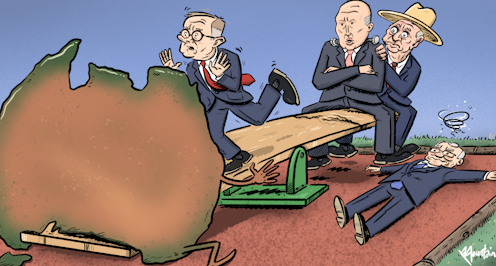Did Australia just make a move to the left?
- Written by Frank Bongiorno, Professor of History, ANU College of Arts and Social Sciences, Australian National University

Political commentators often use the idea of a political spectrum from left to right as shorthand for understanding political ideologies, parties and programs. Derived from the arrangement of the National Assembly in the French Revolution, it has been a remarkably resilient form of political shorthand.
Is it useful is explaining what has happened in the 2022 Australian federal election?
The customary way of considering such matters has been to regard the Liberals and Nationals as parties of the right, and Labor and the Greens as parties of the left. Terms such as centre right and centre left have sometimes been used to provide greater refinement, seen to be necessary especially with the proliferation of xenophobic and extreme parties further to the right in many countries. The term “centre party” has sometimes been used for smaller parties that seem to sit between the others, however uncomfortably – the Australian Democrats was an example.
If the spectrum does indeed remain a useful concept, an argument can be made that the 2022 election discloses an electoral shift to the left. It is perhaps the most significant since the combined momentum of the elections of 1969 and 1972 that brought the Whitlam government to office.
Changes of government in federal politics don’t happen often. There have been eight since the second world war, and three of those were in a turbulent decade between late 1972 and early 1983. Australian voters are in the habit of returning governments and they tend not to discard an incumbent lightly. When they do, it is reasonable to ask if it signals some wider shift in voter attitudes and leanings.
Read more: Albanese wins with a modest program – but the times may well suit him[1]
In particular, Australian voters have normally clung tightly to non-Labor governments. Joseph Lyons won three elections before the war as leader of the United Australia Party (no relation to Clive Palmer’s), while Robert Menzies won seven from 1949 for Liberal-Country party coalitions. His successors managed another couple between them, taking their tally to 23 years of continuous rule.
John Howard won four times for almost 12 years, and Malcolm Fraser three for just over seven. The Coalition government that has just been defeated won three elections under three different leaders. All up, since House of Representatives elections became largely a two-way competition between a government and an opposition in 1910, non-Labor has governed for two-thirds of the time and Labor for one-third.
Labor’s primary vote at this election is on present counting at a historic low of about 32%, but the emphasis placed on this might be producing a misreading of the electoral mood. Once preferences are distributed, the party is currently tracking for a two-party preferred vote of about 52% to the Coalition’s 48%. If maintained, that will be fractionally behind the vote received by Gough Whitlam in 1972 and Kevin Rudd in 2007 (both 52.7%), and just over a point behind Hawke in 1983 (53.2%).
We have used the preferential system[2], known internationally as the Alternative Vote, for House elections since 1918. By the standards of federal elections, in 2022 voters have announced a clear preference for a party regarded as “centre left” or “progressive” over one that is “centre right”, “conservative” or even “liberal”.
The opposition that Australians have been prepared to send into government is led by a man whom few would regard as having the charisma of John Curtin, Gough Whitlam, Bob Hawke or Kevin Rudd. Anthony Albanese displays sincerity, integrity and authenticity, which gave him advantages in comparison with a prime minister whose popularity was in decline. But it is unlikely he has inspired the support that these earlier Labor leaders could mobilise on the basis of strength of personal appeal. He may do so in time, but not this time.
Read more: He's Australia's 31st prime minister. So who is Anthony Albanese?[3]
Albanese pursued a small-target strategy, which might lead one to doubt his election signifies much at all. But this is only part of the story. As the campaign developed, Albanese sounded increasingly in tune with values normally understood as in Labor’s DNA.
He stood up to media and Coalition bullying over his support for maintaining the real wages of low-paid workers. He talked of universal provision in childcare, which has a Whitlamite feel to it. He signalled a strong commitment to the Uluru Statement From the Heart. His language was about caring, co-operation and collaboration, of “we” and “us” more than “you” or “me”.
Labor took seats from the Coalition – a point that is perhaps being lost in the understandable emphasis on the victories of independents and Greens. The swing to Labor in Western Australia looks like it will be between 10% and 11% – no doubt entangled in the politics of the pandemic, but a radical shift nonetheless in a state where Labor usually struggles.
Labor will win seats from the Coalition in Sydney, Melbourne, Perth and Adelaide. Indeed, the Coalition has been nearly wiped out in all of these cities by a combination of Labor, independents and, in Melbourne, Greens.
Labor’s national swing looks to be about 3.6%. As a result, many of its own seats have become safer while it is now in striking distance of Coalition ones. Aston in Melbourne’s affluent eastern suburbs, held by Alan Tudge and an outer island in a sea of red, teal and green, has moved from safe to marginal. Coalition hopes that it could take Hunter in view of the large swing gained there in 2019 and the supposed strength of pro-coal opinion now look faintly ridiculous.
In Brisbane, the Greens have taken seats – possibly three – from both Labor and the Liberals. This might be considered an unambiguous shift to the left by inner-city electorates in Brisbane, although not one from which Labor has been able to benefit.
It is a major breakthrough for the Greens in the lower house, where they previously had just their leader, Adam Bandt, representing Melbourne. This success will greatly magnify their standing in the new parliament, where the government will often need Greens support in the Senate even if it gets a House of Representatives majority.
Greens success will equally worry Labor strategists concerned about their own inner-city strongholds, just as the party’s larger inability to win seats in regional Queensland will remain of concern. But even here, Labor has managed a two-party preferred swing of over 5% on present counting, which might place some seats in striking distance next time.
The rise and rise of the independents has rightly been the story of the election. The central issues of their campaign – climate change, anti-corruption and gender equality – have been turned into the property of “progressives” and “the left” through the ham-fisted efforts of Scott Morrison and the Coalition, support of now questionable value from the Murdoch media, and the place of the environment in the right’s culture wars.
Climate and energy policy, more than any other issue, now defines what it is to be “conservative” and “progressive” in Australia. This is the handiwork of a succession of powerful conservative politicians who saw political advantage in this framing and enjoyed their parties’ relationship with the fossil fuel industry. Tony Abbott, Morrison and Barnaby Joyce have been among the most influential.
Read more: Australian voters have elected their government. Now the Labor Party has to make them believe they were right[4]
They may now behold their achievement. The Liberal Party is a drastically depleted[5] and demoralised force. The Coalition might fall apart. The right-wing populist minor parties such as Pauline Hanson’s One Nation and Clive Palmer’s United Australia Party have performed poorly, with Hanson’s Senate seat in danger – another measure, perhaps, of a general shift to the left.
Australia will have the most progressive parliament for many years. And the Coalition will have some deep soul-searching to do, possibly under a leader – Peter Dutton – who will be a strange but unavoidable choice for a party that needs both to soften its image and change its substance to have any hope of avoiding many years in the wilderness.
References
- ^ Albanese wins with a modest program – but the times may well suit him (theconversation.com)
- ^ preferential system (www.aph.gov.au)
- ^ He's Australia's 31st prime minister. So who is Anthony Albanese? (theconversation.com)
- ^ Australian voters have elected their government. Now the Labor Party has to make them believe they were right (theconversation.com)
- ^ depleted (theconversation.com)
Read more https://theconversation.com/did-australia-just-make-a-move-to-the-left-183611













